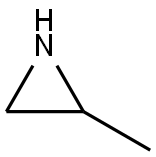General Description
A clear colorless liquid with an ammonia-like odor. Flash point 25°F. Toxic by ingestion, inhalation and through skin absorption. Less dense than water. Vapors are heavier than air. Produces toxic oxides of nitrogen during combustion. Under prolonged exposure to fire or heat the containers may rupture violently and rocket. Used as an organic intermediate.
Reactivity Profile
PROPYLENEIMINE, [INHIBITED] is subject to violent polymerization on contact with an acid. (The inhibitor is intended to prevent polymerization). Incompatible with isocyanates, halogenated organics, peroxides, phenols (acidic), epoxides, anhydrides, and acid halides. Flammable gaseous hydrogen is generated in combination with strong reducing agents, such as hydrides.
Air & Water Reactions
Highly flammable. Soluble in water. Reacts slowly and non hazardously with water to form propanolamine or methylethanolamine.
Hazard
Flammable, dangerous fire risk. Toxic by
ingestion, inhalation, and skin absorption. Upper
respiratory tract irritant and kidney damage. Possi-
ble carcinogen.
Health Hazard
Toxic after acute exposure. Can severely irritate eyes, skin, and lungs.
Potential Exposure
Propyleneimine is used in the modifi-
cation of latex surface coating resins; in the production of
polymers for use in the paper and textile industries as coat-
ings and adhesives.
Fire Hazard
Chemical is extremely flammable; vapors are heavier than air. Toxic oxides of nitrogen are produced during combustion. Avoid acids, strong oxidizers. Thermally unstable. Hazardous polymerization may occur. Contact with acid promotes violent polymerization.
First aid
If this chemical gets into the eyes, remove any
contact lenses at once and irrigate immediately for at least
15 minutes, occasionally lifting upper and lower lids. Seek
medical attention immediately. If this chemical contacts the
skin, remove contaminated clothing and wash immediately
with soap and water. Seek medical attention immediately.
If this chemical has been inhaled, remove from exposure,
begin rescue breathing (using universal precautions, includ-
ing resuscitation mask) if breathing has stopped and CPR if
heart action has stopped. Transfer promptly to a medical
facility. When this chemical has been swallowed, get medi-
cal attention. Give large quantities of water and induce
vomiting. Do not make an unconscious person vomit.
Shipping
UN1921 Propyleneimine, stabilized, Hazard
Class: 3; Labels: 3-Flammable liquid, 6.1-Poisonous
materials.
Incompatibilities
Vapors or liquid form explosive mixture
with air. Incompatible with oxidizers (chlorates, nitrates,
peroxides, permanganates, perchlorates, chlorine, bromine,
fluorine, etc.); contact may cause fires or explosions. Keep
away from alkaline materials, strong bases, strong acids,
oxoacids, epoxides, water, carbonyl compounds; quinones,
sulfonyl halides. May explode in heat. Subject to violent
polymerization in contact with acids. Hydrolyzes in water
to form methylethanolamine.
Chemical Properties
colourless oily fuming liquid
Chemical Properties
Propyleneimine is a fuming, colorless, oily
liquid with a strong ammonia-like odor.
Waste Disposal
Consult with environmental
regulatory agencies for guidance on acceptable disposal
practices. Generators of waste containing this contaminant
(≥100 kg/mo) must conform with EPA regulations
governing storage, transportation, treatment, and waste
disposal. Controlled incineration (incinerator equipped
with a scrubber or thermal unit to reduce nitrogen oxides
emissions).
Uses
Intermediate in production of polymers,
coatings, adhesives, textiles, and paper
finishes.
Uses
The renal papillary toxin.
Definition
ChEBI: 2-Methylaziridine is a member of aziridines.
Carcinogenicity
2-Methylaziridine is reasonably anticipated to be a human carcinogen based on sufficient evidence of carcinogenicity from studies in experimental animals.
Toxics Screening Level
The initial threshold screening level (ITSL) for 1,2-propylenimine is 5 μg/m3 with an 8-hour averaging time.
